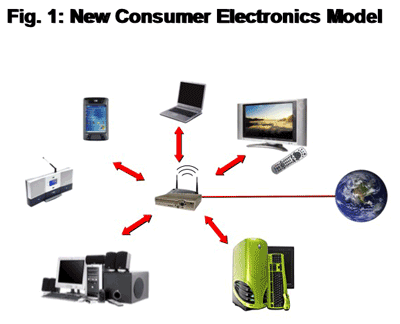New open application architecture fuels consumer storage growth
The move from a closed system to open-application architecture would be a win for all parties
BY ALI SIMNAD
PLX Technology
Sunnyvale, CA
http://www.plxtech.com
The market drivers and the role of consumer-storage devices are evolving from traditional storage capabilities such as backup, file sharing, and capacity extension into media serving, content management, remote access, transcoding, and many more applications. This transition is possible thanks to a new generation of high-speed system-on-a-chip (SoC) devices that have enough CPU power to run multiple applications and connect to several clients/users simultaneously (see Fig. 1 ), with no degradation of service or negative user experience. To take full advantage of this shift in hardware design requires a new and fresh look at application development and distribution.

Fig. 1. A new generation of high-speed system-on-a-chip devices that have enough CPU power to run multiple applications and connect to several clients/users simultaneously.
In the existing model, most applications are “prepackaged” and shipped by the manufacturer. Examples of these applications are media serving, content management, and backup, This model has two major problems. First, it limits the ability of users to customize and upgrade the device they own; no matter what a user’s specific needs are gaming, media serving, data backup — one size is supposed to fit all. Second, this model restricts innovation by third parties such as independent application vendors (IAVs).
Both designers and consumers, therefore, would gain from a new architectural, distribution, and usage model for the future consumer-storage applications. In other words, the move from a closed system to open-application architecture would be a win for all parties.
The open-system challenges
This architectural challenge is not necessarily a technical one. Although there are definitely technical challenges to overcome, the real issues are business — and, some will argue, mindset. Many manufacturers take pride in developing compelling, unique applications as their main means to differentiate and value-add. For example, the EMC LifeLine application designed for managing digital content, backup, music downloading, and many other applications is a key differentiator for EMC’s consumer-storage product line.
These same makers argue that they are in touch with the consumer base and are able to offer the “best solution” to meet consumer demand.
Furthermore, they point to extensive testing and interoperability evaluation they must undertake to make sure that applications can run on their platforms. They also argue that opening up the hardware to untested and unverified applications would be a recipe for disaster. Another drawback would be technical support; today, if there is any technical issue, consumers know who to call — a process that would be far more complicated in an open-system architecture. All are valid arguments.
The rise of independent application vendors
The move into the open system would usher in new players in the home-storage market, the independent application vendors (IAVs). The whole application ecosystem is getting more diverse and requires domain expertise (something that most brands lack). So the value proposition of IAVs would be highly innovative solutions for vertical market applications. These are the people who would develop the actual applications that consumers would use in their devices.
At first glance, there might be a perceived fear of competition between a storage-system maker (the brand) and an IAV who would develop and sell the applications, thus drawing consumer dollars away from the brand. However, each can bring to the table a lot of complementary value. So if they join forces, this could be the most lucrative business arrangement for all parties.
Currently, hardware manufacturers use the latest in consumer-storage technology, from companies such as PLX Technology and its recently introduced NAS 7800 family of SoCs, to develop hardware, then sell it at retail or e-tail. The revenue is generated from one-time sale of the product. An alternative business model provides an ongoing revenue stream for those companies by partnering with IAVs to sell additional applications years after the initial purchase. These purchases could be application subscriptions for a monthly charge or one-time sales of new applications. The manufacturers then could provide certification, technical support, use of their distribution channel, and brand recognition, while IAVs concentrate on innovative applications for vertical markets.
The mindset change
As we have seen, the iPhone has been the agent of change in the smart phone market. We now need to have a “pioneer” in the consumer storage market, one that would break the barriers and move from a closed system to a dynamic open system. It’s up the hardware manufacturers to be the agents of change in the consumer storage. ■
Advertisement
Learn more about PLX Technology





